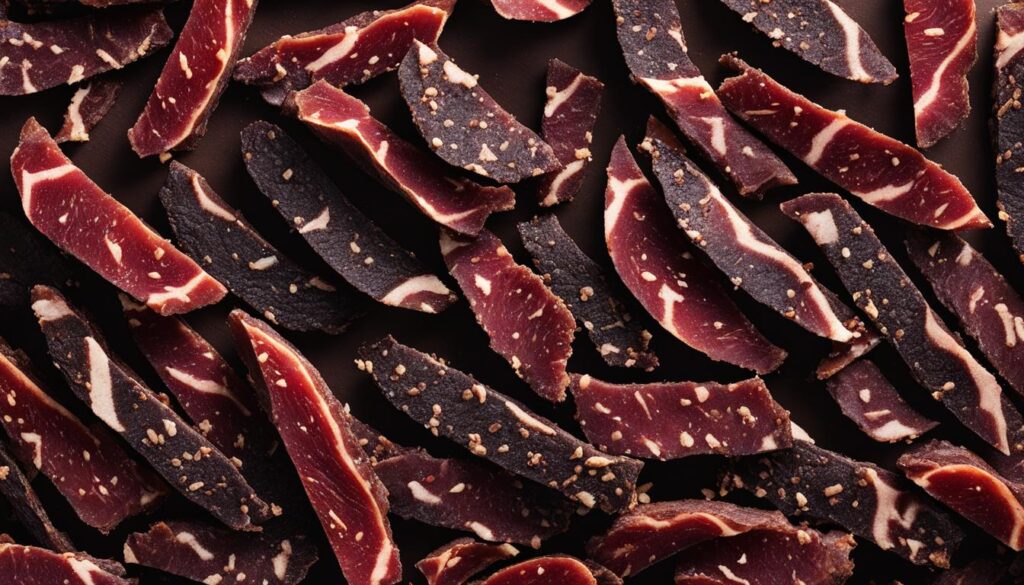Perfect Biltong Spice for Authentic South African Flavour
If you’re a fan of biltong, the beloved South African dried meat snack, you know that its unique and delicious flavor is irreplaceable. Making your own biltong at home allows you to customize the taste and experience the authentic South African flair.
To achieve the best results, it all starts with the perfect biltong spice blend. The traditional mix includes coriander, black pepper, salt, vinegar, and Worcestershire sauce, creating a harmonious blend that elevates the flavor of the beef. Getting the right balance of these spices is crucial for that distinct South African taste.
If you’re ready to embark on your homemade biltong journey, we have the recipe to help you get started. But before we dive into the details, let’s explore why the right spice blend is so crucial.
- Creating the perfect biltong spice blend is essential for an authentic South African flavor.
- The traditional spice mix includes coriander, black pepper, salt, vinegar, and Worcestershire sauce.
- Getting the ratios right is crucial for achieving the ideal balance of flavors.
- Homemade biltong allows you to customize the taste to suit your preferences.
- Stay tuned for the recipe to make your own delicious biltong at home.
The Curing and Drying Process
In the process of making biltong, there are two crucial steps that determine the final flavor and texture: curing and drying. While there may be varying opinions on methods and spice mixes for curing, keeping it simple and avoiding unnecessary steps is key. Many recipes suggest multiple stages of curing and washing off spices, but a single coating of the spice mix is sufficient to achieve the desired results.
The traditional spice blend for curing biltong typically includes salt, coriander, and black pepper, which work together to enhance the flavor and preserve the meat. This simple mixture ensures that each bite of biltong is packed with a delicious combination of savory and aromatic flavors.
Once the meat is properly coated with the spice blend, it’s time to move on to the drying process. Temperature and airflow play a crucial role in achieving the perfect texture and preserving the biltong. It is recommended to hang the biltong in a well-ventilated area with a temperature between 20-24°C (68-75°F) and a relative humidity of around 50-60%. This optimal environment allows the biltong to dry evenly and develop the desired texture.
It’s important to remember that proper airflow is essential during the drying process. Ensuring that air can circulate around the biltong will help prevent the growth of mold and ensure even drying. Hanging the biltong on hooks or using a biltong box with proper ventilation can help achieve the desired airflow and drying conditions.
The drying time can vary depending on the thickness of the meat and the desired level of dryness. On average, biltong can take anywhere between 3-7 days to dry completely. It’s important to check the biltong regularly during the drying process to ensure that it is drying evenly and to adjust the airflow if necessary.
Once the biltong is dry to your liking, it’s ready to be enjoyed! Whether it’s a snack for a road trip, a protein-packed addition to your meals, or a flavorful treat to share with friends, homemade biltong is sure to impress.

With the proper curing and drying process, you can create biltong that captures the authentic South African flavors and textures that you love. Experiment with different spice blends and drying times to find the perfect combination that suits your taste. So why not give it a try? Make your own delicious biltong today!
Tips and Tricks for Making the Best Biltong
When it comes to making the best biltong, attention to detail is key. Starting with the right ingredients and preparing the meat properly can make all the difference in achieving that perfect, authentic South African flavor.
First and foremost, selecting the right meat is crucial. Beef or game meat are the preferred choices due to their taste and texture. Popular cuts like silverside or topside work well, but don’t be afraid to experiment with different cuts to find your personal favorite.
Once you have your meat, it’s important to prepare it properly. Begin by removing any excess fat, as this can hinder the drying process and shorten the shelf life of your biltong. Cut the meat into strips, ensuring they are of uniform thickness to promote even curing and drying.
While the curing and drying process helps to preserve the meat and enhance its flavor, it’s important to note that mold can occasionally develop. To prevent this, make sure the meat is adequately coated with the biltong spice and vinegar mixture. Additionally, maintaining proper temperature and airflow during the drying process can help minimize the risk of mold formation.
FAQ
What spices are in a traditional biltong spice mix?
The traditional spice mix for biltong includes coriander, black pepper, salt, vinegar, and Worcestershire sauce.
How do I make my own biltong spice blend?
To make your own biltong spice blend, start with a mixture of coriander, black pepper, salt, vinegar, and Worcestershire sauce. Experiment with the ratios to find the perfect balance of flavors.
Can I use different cuts of meat for biltong?
Yes, you can use different cuts of beef or game for biltong. Silverside or topside cuts are popular choices, but feel free to experiment with different cuts to find your favorite.
Should I remove excess fat from the meat before making biltong?
Yes, it’s important to remove excess fat from the meat before making biltong. This helps with the drying process and extends the shelf life of the biltong.
Is it necessary to cure the meat multiple times for making biltong?
No, it is not necessary to cure the meat multiple times for making biltong. A single coating of the spice mix, including salt, coriander, and black pepper, is sufficient to cure the meat.
How should I dry the biltong after curing?
After curing the meat, hang it in a well-ventilated area with good airflow. Maintain a consistent temperature of around 50-60 degrees Celsius (120-140 degrees Fahrenheit) for optimal drying.
